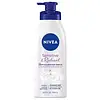What's inside
What's inside
 Key Ingredients
Key Ingredients

 Benefits
Benefits

 Concerns
Concerns

 Ingredients Side-by-side
Ingredients Side-by-side

Water
Skin ConditioningGlycerin
HumectantIsopropyl Palmitate
EmollientPetrolatum
EmollientDimethicone
EmollientCetyl Alcohol
EmollientPhenoxyethanol
PreservativeSodium Polyacrylate
AbsorbentCetearyl Olivate
Caprylyl Glycol
EmollientEthylhexylglycerin
Skin ConditioningSorbitan Olivate
EmulsifyingParfum
MaskingCarbomer
Emulsion StabilisingSodium Hyaluronate
HumectantSodium Hydroxide
BufferingBlue 1 Lake
Cosmetic ColorantWater
Skin ConditioningGlycerin
HumectantCetearyl Alcohol
EmollientC15-19 Alkane
SolventGlyceryl Stearate Se
EmulsifyingIsopropyl Palmitate
EmollientGlyceryl Stearate
EmollientPetrolatum
EmollientPanthenol
Skin ConditioningHelianthus Annuus Seed Oil
EmollientPrunus Amygdalus Dulcis Oil
Skin ConditioningGlycine Soja Oil
EmollientHydrolyzed Pearl
Skin ConditioningTocopheryl Acetate
AntioxidantHydrogenated Coco-Glycerides
EmollientSodium Cetearyl Sulfate
CleansingPhenoxyethanol
PreservativeEthylhexylglycerin
Skin ConditioningPantolactone
HumectantCarbomer
Emulsion StabilisingSodium Hydroxide
BufferingCitric Acid
BufferingSodium Citrate
BufferingWater, Glycerin, Cetearyl Alcohol, C15-19 Alkane, Glyceryl Stearate Se, Isopropyl Palmitate, Glyceryl Stearate, Petrolatum, Panthenol, Helianthus Annuus Seed Oil, Prunus Amygdalus Dulcis Oil, Glycine Soja Oil, Hydrolyzed Pearl, Tocopheryl Acetate, Hydrogenated Coco-Glycerides, Sodium Cetearyl Sulfate, Phenoxyethanol, Ethylhexylglycerin, Pantolactone, Carbomer, Sodium Hydroxide, Citric Acid, Sodium Citrate
 Reviews
Reviews

Ingredients Explained
These ingredients are found in both products.
Ingredients higher up in an ingredient list are typically present in a larger amount.
Carbomer is a polymer of acrylic acid. Its main role is to create a gel consistency.
A high amount of carbomer can cause pilling or balling up of products. Don't worry, most products contain 1% or less of carbomer.
Ethylhexylglycerin (we can't pronounce this either) is commonly used as a preservative and skin softener. It is derived from glyceryl.
You might see Ethylhexylglycerin often paired with other preservatives such as phenoxyethanol. Ethylhexylglycerin has been found to increase the effectiveness of these other preservatives.
Glycerin is already naturally found in your skin. It helps moisturize and protect your skin.
A study from 2016 found glycerin to be more effective as a humectant than AHAs and hyaluronic acid.
As a humectant, it helps the skin stay hydrated by pulling moisture to your skin. The low molecular weight of glycerin allows it to pull moisture into the deeper layers of your skin.
Hydrated skin improves your skin barrier; Your skin barrier helps protect against irritants and bacteria.
Glycerin has also been found to have antimicrobial and antiviral properties. Due to these properties, glycerin is often used in wound and burn treatments.
In cosmetics, glycerin is usually derived from plants such as soybean or palm. However, it can also be sourced from animals, such as tallow or animal fat.
This ingredient is organic, colorless, odorless, and non-toxic.
Glycerin is the name for this ingredient in American English. British English uses Glycerol/Glycerine.
Learn more about GlycerinIsopropyl Palmitate is a texture enhancer and emollient. It is an ester of isopropyl alcohol and palmitic acid.
Palmitates are emollients. Emollients help keep your skin soft and smooth by creating a barrier that traps moisture in.
When added to cosmetics, Isopropyl Palmitate creates a silky texture and improves spreadability.
Isopropyl Palmitate may not be fungal acne safe. It can worsen acne prone skin.
Learn more about Isopropyl PalmitatePetrolatum is more commonly known as petroleum jelly. It is created by mixing waxes and mineral oils.
This ingredient is effective at reducing water loss by 99%. This is because it is an occlusive. Occlusives create a hydrophobic barrier on the skin to prevent evaporation. This property makes it great for hydrating dry skin.
Pro tip: Use occlusives, such as this ingredient, on damp skin for the best results.
The quality or origin of petrolatum is only known when disclosed by the brand. Most cosmetic petrolatum has gone through several purification stages.
Another benefit of occlusives is it protects your skin against infection or allergies.
Petrolatum may not be safe for fungal-acne. Studies show mineral oil / petroleum leads to the growth of M. Furfur, a type of yeast.
Learn more about PetrolatumPhenoxyethanol is a preservative that has germicide, antimicrobial, and aromatic properties. Studies show that phenoxyethanol can prevent microbial growth. By itself, it has a scent that is similar to that of a rose.
It's often used in formulations along with Caprylyl Glycol to preserve the shelf life of products.
Sodium Hydroxide is also known as lye or caustic soda. It is used to adjust the pH of products; many ingredients require a specific pH to be effective.
In small amounts, sodium hydroxide is considered safe to use. However, large amounts may cause chemical burns due to its high alkaline.
Your skin has a natural pH and acid mantle. This acid mantle helps prevent harmful bacteria from breaking through. The acid mantle also helps keep your skin hydrated.
"Alkaline" refers to a high pH level. A low pH level would be considered acidic.
Learn more about Sodium HydroxideWater. It's the most common cosmetic ingredient of all. You'll usually see it at the top of ingredient lists, meaning that it makes up the largest part of the product.
So why is it so popular? Water most often acts as a solvent - this means that it helps dissolve other ingredients into the formulation.
You'll also recognize water as that liquid we all need to stay alive. If you see this, drink a glass of water. Stay hydrated!
Learn more about Water